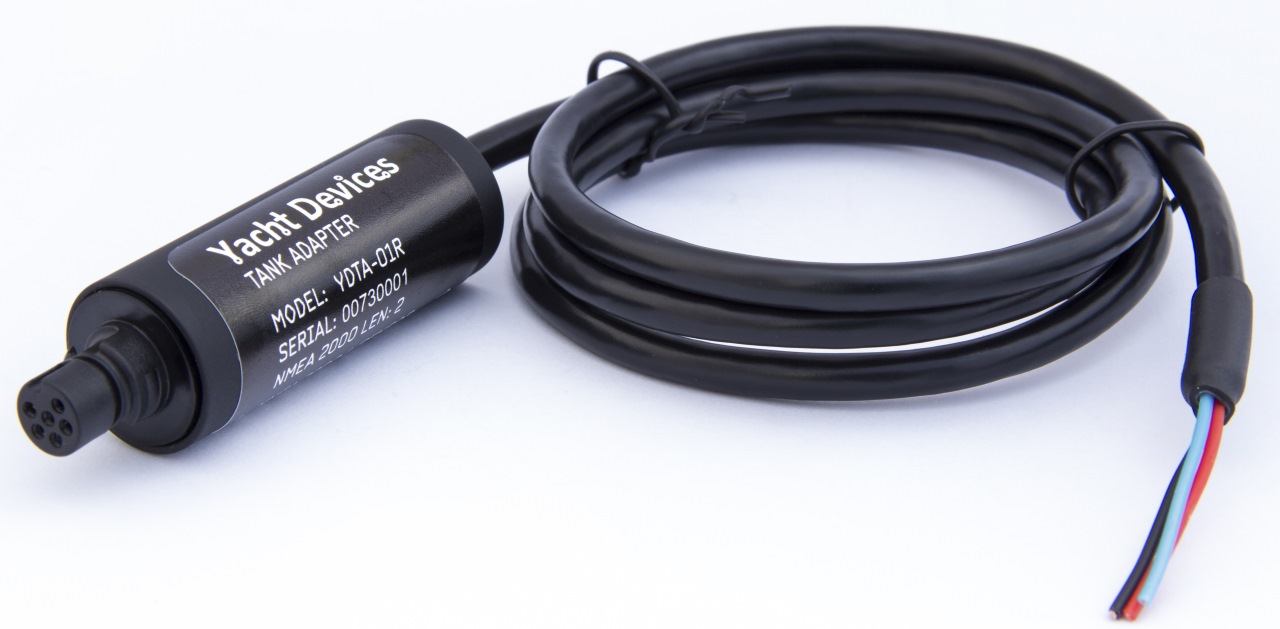July 23, 2018 Tank Adapter for resistive sensors is released
We are glad to present an NMEA 2000 adaptor which works with any resistive level sensors and can work in parallel with analog gauges and the Volvo Penta MDI

Liquid level is a poorly measured value on many boats. A gauge can show 50% when a tank actually has 15%, and after a few seasons and multiple refueling, the owner forms a "corrections" table in his mind. Resistive sensors can show the liquid level with sufficient accuracy, but the problem is with analog gauges. Most boats have non-rectangular tanks, and the liquid level is not directly proportional to the volume.
What advantages are there from switching from an analogue solution to a digital one?
- True readings. Our Adapter offers 12-point calibration which is enough to describe any shape with reasonable accuracy.
- See it anywhere. Data will be available for all NMEA 2000 devices, and you will able to see the fuel level on MFD and instrumental displays. You can configure a page on your MFD to have all tanks on one page, and check all tank levels in a single glance.
- Usage history. The Adapter can record liquid level to the MicroSD card, but you can also use a recording device like our Voyage Recorder to store data from multiple Adapters along with all other vessel data.
- Remote access. If you have a Wi-Fi network with remote access on your boat, you can use our Wi-Fi Gateway to see all your tanks right from a browser or marine apps.
- Fuel alarms. A modern MFD can calculate time-to-empty and distance-to-empty values, display fuel range rings and warn when fuel level is low.
The best thing is that you do not need to get rid of your analog gauge. The Adapter can work in parallel with 2-coil (most popular) or 1-coil analog 12-Volt gauges and Volvo Penta MDI. It does not effect the analog gauge readings. If you have a combined gauge where you choose the value to display with a button, the Adaptor will smoothly work with it, too.
The Adapter can work with any type of sensor: European, US, Japan, and with any non-standard sensor with resistance up to 400 Ohms. The tank number (from 1 to 16) and liquid type (diesel, gasoline, fresh water, waste, etc.) can also be configured.
You can configure the Adapter in two ways. The Adapter is equipped with a MicroSD slot for firmware updates, data logging and configuration. You can save the current configuration to a text file on a MicroSD card, and upload new settings from a simple text file. This way does not require any equipment other than a laptop or smartphone with a card reader and text editor.
It can also be configured with special "Installation Description" strings. Some MFD's allow entering a text to device's properties. This text is usually used to save installation notes, the device location or the installer's contacts. You can also enter these strings with our free CAN Log Viewer software, connected to NMEA 2000 with the USB Gateway or Wi-Fi Gateway. This way allows you to sit on a sofa and set up multiple Adapters without needing physical access. The last version of the CAN Log Viewer has a dedicated window which displays data from a multiple tanks of any type.
The Tank Adapter is already certified by National Marine Electronics Association.
The Adaptor costs USD $149. Models with NMEA 2000 Micro Male and SeaTalk NG connectors are in stock. You can learn more about the Adaptor on the product page or download the Manual.
Next articles:
- Engine Gateway's firmware update 1.21 / July 18, 2018
- Updates for Wi-Fi and USB Gateways / June 22, 2018
- Firmware update for the J1708 Engine Gateway / May 23, 2018
Previous articles:
- New model of our bi-directional gateway between NMEA 0183 and NMEA 2000 / August 7, 2018
- Voyage Recorder YDVR-04 firmware and software updates / August 21, 2018
- Engine Gateway's firmware update 1.22 / August 22, 2018
See also: recent news, all news...